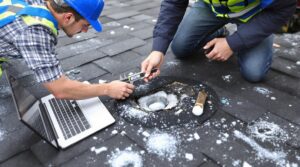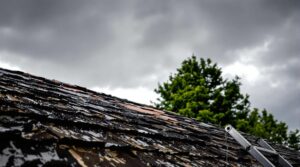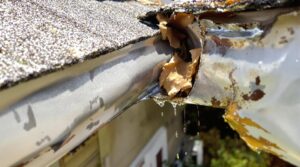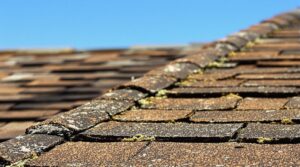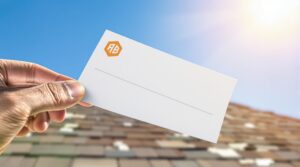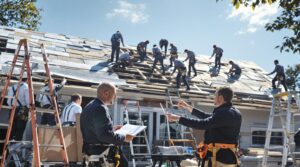Ever wondered when your insurance company will foot the bill for a shiny new roof? Let’s crack this puzzle together! Understanding how insurance covers roof replacement can be a bit complicated. Typically, your policy will dictate whether you qualify for a full or partial replacement based on factors like age, damage, and the cause of the issue. It’s essential to review your coverage details and consult with your insurance agent to ensure you maximize your benefits when that shiny new roof becomes a necessity.
Think of your homeowner's insurance as an umbrella – it's there to protect you when unexpected storms hit. Your policy typically jumps into action when Mother Nature throws a tantrum: fierce storms, golf ball-sized hail, howling winds, or that pesky neighbor's tree taking an unwanted dive onto your house.
But here's the catch – you've got to act fast! Just like documenting a fender bender, you'll need to gather evidence within 72 hours of the incident. This means:
- Professional roof inspections
- Clear photographs of the damage
- Detailed damage assessments
Don't expect your insurance to rescue you from Father Time, though. They won't cover your roof's natural aging process – those worn-out shingles from decades of sun exposure aren't their problem. It's like expecting your car insurance to pay for an oil change – it just doesn't work that way.
Success in getting your claim approved boils down to three key factors:
- Understanding your policy's fine print
- Staying within coverage limits
- Working with qualified insurance adjusters
Remember, your insurance is your safety net for the unexpected, not a maintenance plan. Keep your roof in tip-top shape, and when disaster strikes, you'll be ready to navigate the claims process like a pro!
Key Takeaways
Wondering When Your Insurance Will Cover That New Roof? Let's Break It Down!
Think of your roof as a protective shield – when it takes a hit, your insurance might just come to the rescue. Here's what typically gets you the green light for coverage:
Nature's Surprises:
- That unexpected windstorm that sent shingles flying
- Golf ball-sized hail leaving your roof looking like the surface of the moon
- Lightning strikes that weren't kind to your home
- That massive oak tree that decided to take a nap on your house
The Golden Rules of Coverage:
Your insurance provider wants to see that Mother Nature – not Father Time – caused the damage. Just like a car accident, the damage needs to be sudden and unexpected. Regular wear and tear? That's on you, friend.
Time is of the Essence:
Got damage? Don't wait! You'll need to:
- Document everything within 72 hours (think photos, videos)
- Get a professional inspector up there
- Have a trusted contractor assess the damage
Show Me the Money:
Before your insurance opens their wallet:
- You'll need to handle your deductible
- Prove the damage exceeds replacement requirements
- Have maintenance records handy
Pro Tip: If your roof is under 20 years old and you've been diligent with maintenance, you're more likely to score a full replacement rather than just repairs. Think of it as a reward for being a responsible homeowner!
Common Types of Covered Roof Damage
Homeowners insurance typically covers a wide range of roof damage scenarios resulting from sudden, unexpected events. Coverage includes destruction caused by various wind patterns, from severe storms to hurricanes and tornadoes. Different hail types, regardless of size or intensity, are covered when they impact roofing materials.
Insurance protection extends to damage from natural elements such as snow, ice, and falling trees or debris. Lightning strikes and subsequent electrical surges that affect the roof structure are included in standard coverage.
Fire-related incidents, including both direct flame damage and resulting smoke exposure, typically warrant insurance compensation. Additionally, structural damage from burst pipes, accidental water leaks, and vandalism falls under covered perils, ensuring complete protection for homeowners facing unexpected roof damage. With replacement cost value coverage, homeowners can receive full compensation for repairs minus their deductible.
Essential Insurance Coverage Requirements
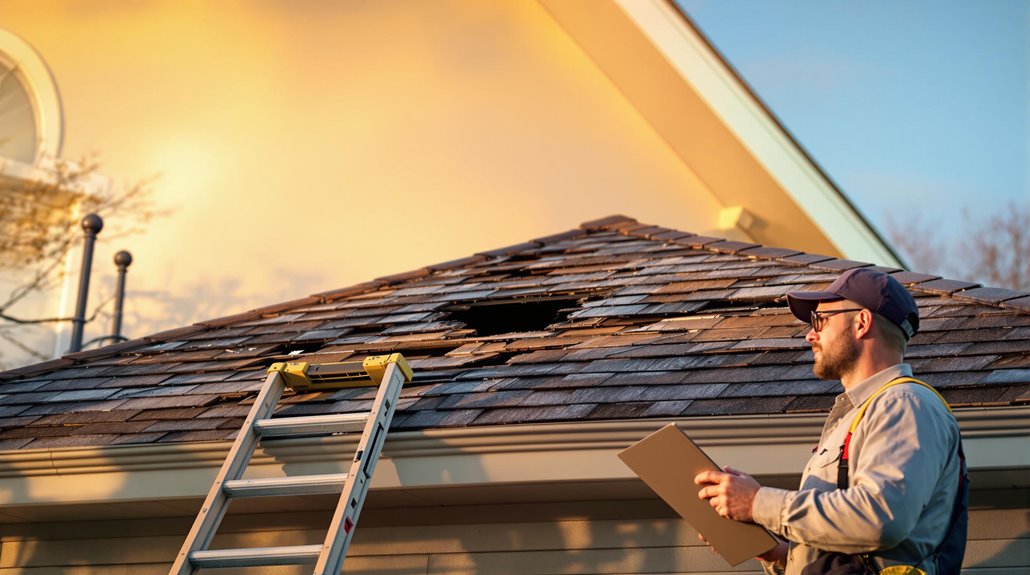
Insurance companies require specific documentation and proof when processing claims for storm-related roof damage.
Policy terms must precisely match the type and extent of damage sustained during the covered event.
Homeowners need to maintain detailed records of the damage, including photographs, professional assessments, and repair estimates that align with their policy's stipulated coverage requirements.
Professional roof inspections within 72 hours of damage provide the strongest evidence for successful insurance claims.
Storm Damage Proof Requirements
Proving storm damage to a roof requires extensive documentation and adherence to specific insurance requirements.
Insurance companies mandate high-quality photographic evidence and thorough written descriptions that detail the extent of weather damage.
This impact documentation must clearly demonstrate that the damage resulted from extreme weather events such as tornadoes, hail, or severe storms.
Property owners must obtain a professional assessment from a qualified roofer who can verify the damage and provide detailed repair estimates.
The documentation package should include before-and-after condition reports, receipts for any emergency repairs, and records of all communication with the insurance provider.
Having a roofing professional present during the insurance adjuster's inspection can help guarantee accurate damage assessment and improve claim outcomes.
Working with public insurance adjusters can increase storm damage settlement amounts by up to 800% compared to handling claims independently.
Policy Terms Must Match
Understanding policy terms and matching coverage requirements stands as a critical first step in securing roof replacement insurance. Policy compliance involves verifying specific coverage types, including standard replacement cost coverage or limited roof endorsements, particularly for roofs over 11 years old.
Coverage verification encompasses multiple factors: the 16 named perils covered under standard policies, age-related restrictions, and specific exclusions. Insurance providers typically mandate age thresholds, commonly 20 years, beyond which coverage may be limited to actual cash value minus depreciation.
Homeowners must confirm their policy's stance on normal wear, maintenance requirements, and cosmetic damage, as these are generally excluded. Additionally, dwelling coverage limits and area-specific risks influence the extent of available coverage, making thorough policy review essential for proper protection. Working with public adjusters can increase claim payouts by 20-50% when filing for roof replacement coverage.
Steps to Document Roof Damage
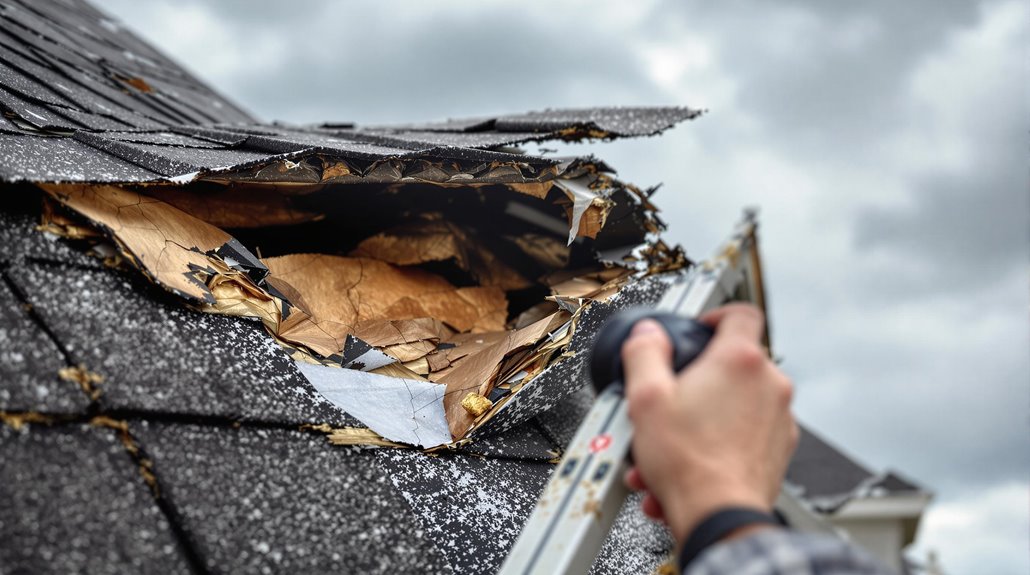
Proper documentation of roof damage begins with capturing thorough photographic evidence from multiple angles before any repairs are initiated.
Written documentation should include detailed descriptions of all visible damage, weather conditions during the incident, and the date and time when damage was discovered.
Maintaining organized records of all repair estimates, contractor communications, and completed work serves as vital supporting evidence for insurance claims.
Working with a public adjuster can increase insurance claim settlements by 20-800% through their expertise in documentation and policy interpretation.
Take Clear Photos First
Documenting roof damage thoroughly with clear photographs serves as essential evidence for insurance claims. When capturing images, proper lighting and camera angles substantially impact the quality of documentation. Start with wide-angle shots of the entire roof, then progress to detailed close-ups of specific damage areas. Working with public adjusters increases settlements by 30-50% for property damage claims.
| Documentation Type | Required Elements | Purpose |
|---|---|---|
| Wide Shots | Full roof views from multiple angles | Establishes overall damage context |
| Close-up Photos | Damaged areas with size reference | Details specific damage points |
| Interior Images | Water stains, ceiling damage | Demonstrates leak impact |
Professional assistance may be valuable for thorough documentation. Enable timestamp features on cameras to verify when photos were taken, and maintain an organized system for storing all visual evidence. This systematic approach helps expedite insurance claims and guarantees complete coverage of all damage points.
Use Detailed Written Notes
Meticulous written notes serve as a critical component of the roof damage documentation process.
Detailed recordkeeping guarantees accurate information for insurance claims and creates a thorough timeline of events.
Written documentation should include specific details about the damage, temporary repairs, and all interactions with insurance representatives and contractors.
- Document the exact date, time, and nature of the damage-causing incident
- Record all communication with insurance adjusters, including names, dates, and discussion points
- Maintain a detailed log of temporary repairs and associated costs
- Create a chronological timeline of events, including inspections, estimates, and repair work
This systematic approach to documentation strengthens the insurance claim by providing verifiable evidence of the damage and subsequent actions taken to address it.
Working with public adjusters can increase insurance claim settlements by up to 800% through their expertise in documentation and assessment procedures.
Save All Repair Records
Complete repair records serve as essential evidence when filing an insurance claim for roof damage. Homeowners should maintain organized repair files containing all documentation related to roof maintenance, repairs, and contractor services. These files should include dated receipts, contractor estimates, and detailed descriptions of work performed.
Insurance companies require exhaustive receipt records to process roof damage claims effectively. This includes documentation of temporary repairs, emergency services, and any associated costs such as hotel stays due to roof-related displacement.
Maintaining chronological records of all roof-related expenses, including materials and labor, strengthens the claim's validity. Properly organized documentation should also include photos before and after repairs, contractor credentials, and warranties for materials used. These records demonstrate the property owner's due diligence in maintaining the roof's integrity.
Working with public adjusters on your roof damage claim can increase settlement amounts by 30-50% compared to handling the claim independently.
What Your Insurance Won't Cover
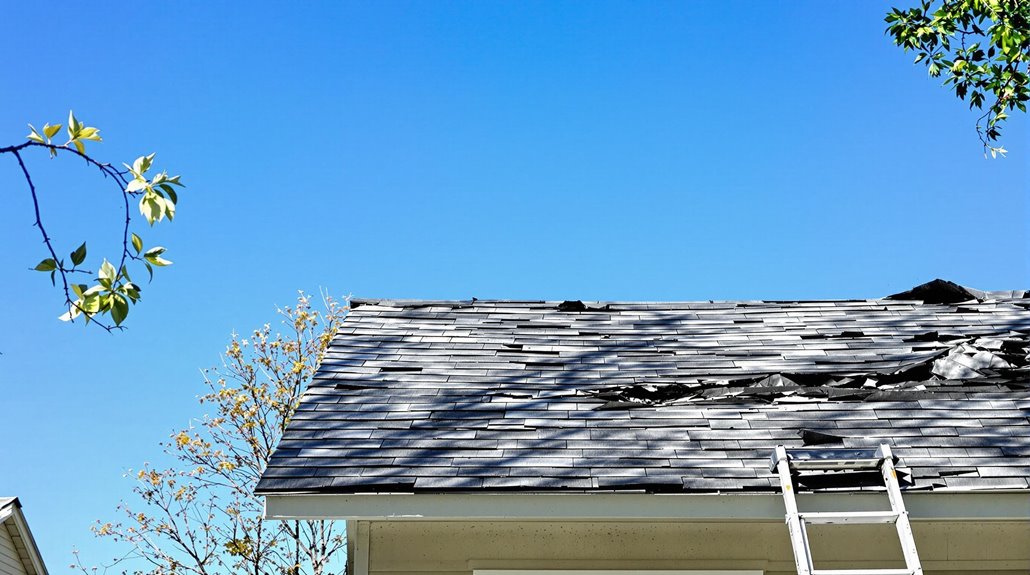
Understanding the exclusions in homeowners insurance policies is essential for protecting against unexpected roof repair costs.
Insurance providers typically exclude coverage for gradual deterioration and maintenance issues that develop over time.
Policies often contain specific limitations regarding roof age, condition, and the number of shingle layers present.
Common exclusions that homeowners should be aware of include:
- Damage from wear and tear or lack of proper maintenance
- Leaks resulting from unresolved maintenance issues or age-related deterioration
- Repairs needed due to inherent defects in roof materials
- Interior damage caused by water entering through existing roof problems
Additionally, some policies include windstorm and hail exclusions through specific endorsements, which can leave homeowners fully responsible for repairs and resulting interior damage.
Coverage may also be limited for unattached structures unless specifically included in the policy.
Only public adjusters help maximize claims for natural disaster damage to roofs.
Understanding Your Policy Coverage
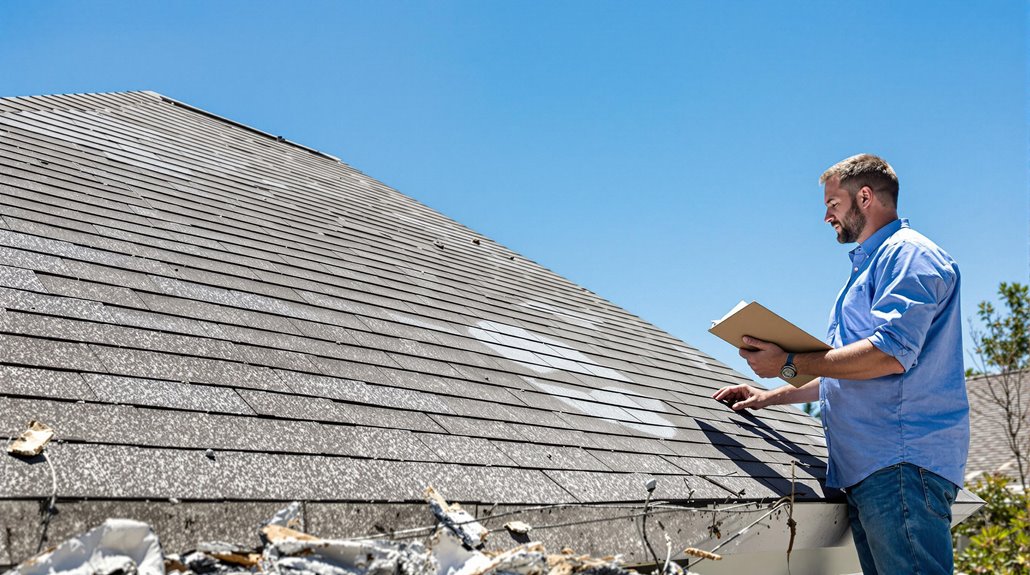
While knowing what insurance won't cover helps homeowners prepare for potential expenses, reviewing the specifics of policy coverage provides a clear framework for determining when insurers will pay for a new roof. Understanding policy types is essential for coverage verification, with dwelling coverage protecting the main structure and other structures coverage extending to detached buildings.
Most policies cover damage from extreme weather events, including hail storms, windstorms, and tornadoes.
The payment process typically involves Replacement Cost Value (RCV) policies, which provide two payments: actual cost value and recoverable depreciation.
Deductible implications affect the final payout amount, as homeowners must meet their deductible before coverage begins.
For structural damage requiring replacement, insurers generally cover costs when caused by covered perils, subject to policy limits and exclusions.
Public adjusters can assist homeowners in reviewing underpaid claims to ensure fair compensation for roof damage.
Working With Insurance Adjusters

Successfully maneuvering through the insurance claims process requires effective collaboration with insurance adjusters, who play a pivotal role in evaluating roof damage and determining coverage.
Proper adjuster etiquette involves maintaining detailed documentation protocols throughout the inspection process, including photographs, videos, and written records of all communications. Having a qualified roofing contractor present during the adjuster's inspection helps guarantee accurate damage assessment and agreement on necessary repairs.
- Document all roof damage with thorough photos and videos before the adjuster arrives
- Maintain detailed records of all communications, including dates and times
- Guarantee the roofing contractor accompanies the adjuster during inspection
- Request written confirmation of the adjuster's findings and recommendations
The adjuster will assess factors such as roof age, maintenance history, and extent of damage to determine appropriate coverage under the policy terms.
Filing a Successful Roof Insurance Claim
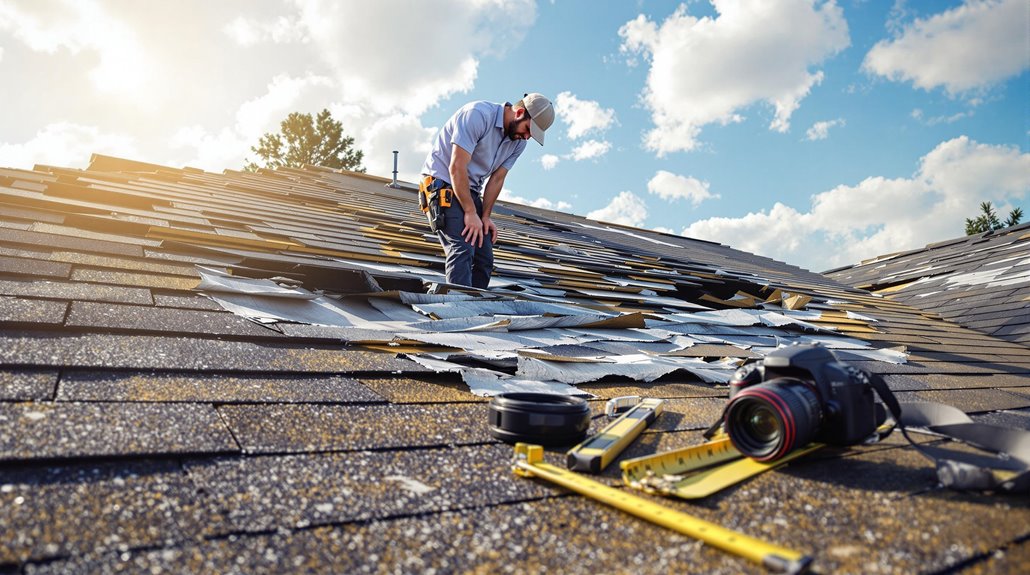
Filing a successful roof insurance claim requires meticulous attention to detail and thorough documentation from start to finish. The claim preparation process begins with capturing extensive photographic evidence of all damage, including measurements and scale references.
Property owners should maintain detailed records of the incident date, weather conditions, and any emergency repairs undertaken.
Effective adjuster communication is vital for claim approval. This includes being present during inspections, providing organized documentation of all damages, and maintaining clear correspondence records.
Property owners should promptly submit all required paperwork, including professional roofing assessments and repair estimates. Regular follow-up on claim status and maintaining detailed logs of all interactions with the insurance provider helps guarantee proper claim processing.
Understanding policy coverage and meeting submission deadlines are essential elements for maximizing settlement potential.
Emergency Repairs and Reimbursement
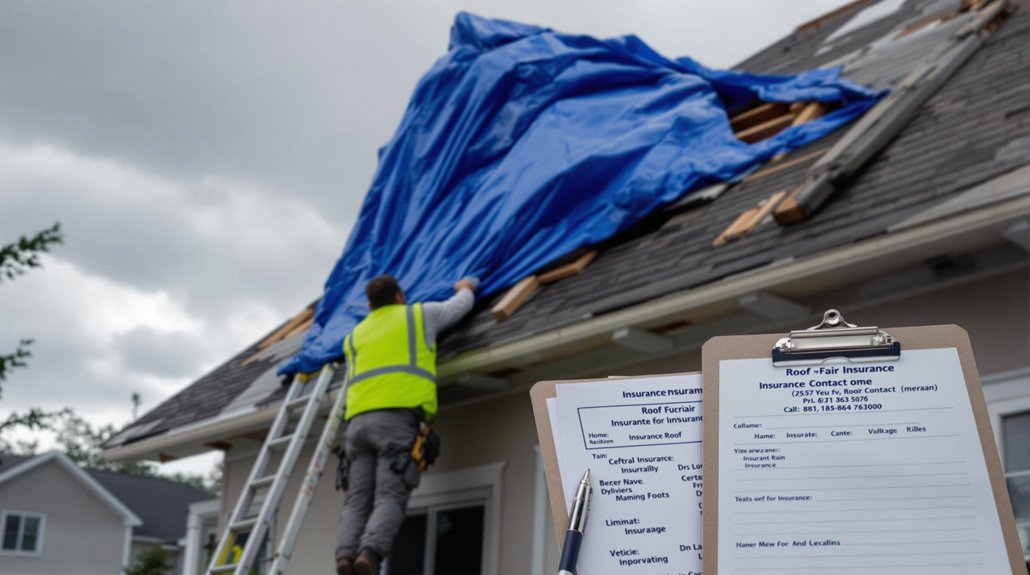
Emergency roof repairs demand swift action to prevent additional property damage and maintain insurance coverage eligibility.
Insurance companies typically reimburse necessary emergency tarping and temporary patches when properly documented. Homeowners should photograph damages, obtain detailed estimates, and keep all repair receipts for claim processing.
- Contact insurance provider immediately after roof damage occurs
- Document all damage with photos and videos before emergency repairs
- Install temporary protection using tarps or patches, costing $150-$1500
- File claims promptly with complete documentation of expenses
Insurance reimbursement for emergency repairs usually occurs within 30-60 days of claim approval.
Homeowners should remain vigilant against repair scams by obtaining detailed estimates and selecting reputable contractors for temporary fixes. The insurance adjuster's inspection will determine coverage extent and validate emergency repair expenses.
Policy Types and Coverage Limits
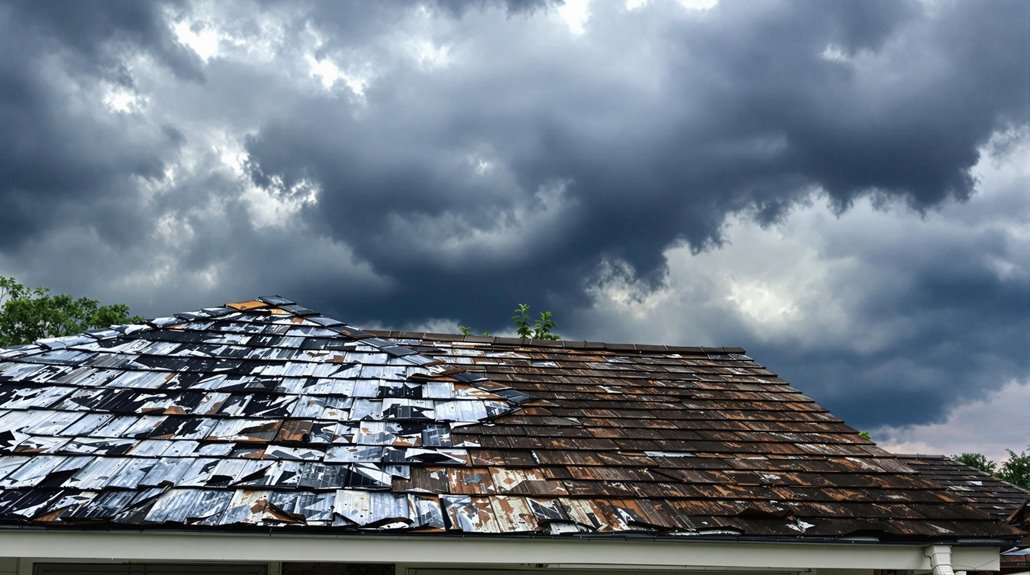
Understanding roof insurance policy types and coverage limits is essential for homeowners seeking appropriate protection for their properties. Policy basics include Replacement Cost Value (RCV), which covers full replacement minus deductible, and Actual Cash Value (ACV), which factors in depreciation. Limited roof endorsements offer preset coverage percentages based on roof age and type.
Coverage maximums vary by policy type and are subject to deductibles and exclusions. While RCV policies provide the most complete protection, covering full replacement costs, ACV policies pay only the depreciated value.
Limited endorsements may restrict coverage based on predetermined percentages. Factors such as roof age, maintenance history, and geographic location influence both available coverage options and potential claim payouts. State regulations can also affect policy provisions and coverage limits.
The Benefits Of Consulting A Public Adjuster
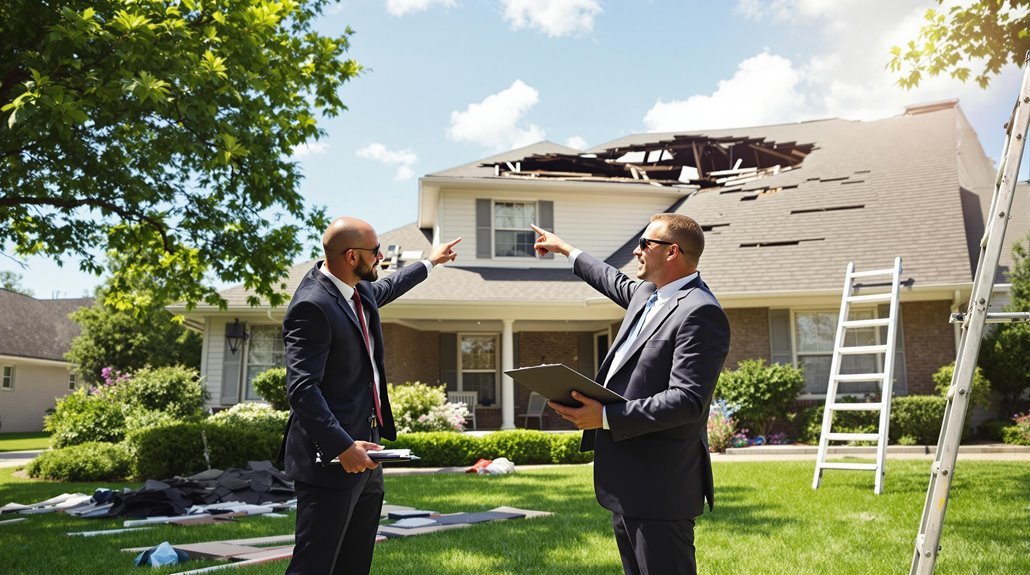
Public adjusters provide professional expertise in handling complex roof damage insurance claims through objective assessments and thorough documentation.
Their knowledge of insurance policies and procedures helps streamline the claims process while advocating for policyholder interests.
Studies indicate that claims handled by public adjusters often result in higher settlements compared to those filed independently, making their services valuable for maximizing coverage for roof replacements.
Expertise In Insurance Claims
Insurance claims for roof damage can be complex and challenging to navigate, making the expertise of a public adjuster invaluable.
These professionals possess specialist knowledge of insurance policies and procedures, guaranteeing thorough claim management and maximizing potential settlements. Their claims expertise enables them to interpret complex policy language and identify coverage aspects that property owners might overlook.
- Thorough understanding of insurance policy terms and conditions
- Professional assessment and documentation of roof damage
- Strategic negotiation skills with insurance carriers
- Expertise in identifying hidden damages and additional coverage opportunities
Public adjusters manage all aspects of the claims process, from initial documentation to final settlement negotiations.
Their technical knowledge helps guarantee that claims are properly presented, documented, and settled according to policy terms, ultimately working to secure fair compensation for the policyholder.
Objective Damage Assessment
A thorough damage assessment forms the foundation of any successful insurance claim for roof replacement. Licensed adjusters conduct extensive property evaluations to document and determine the full extent of damages, providing essential evidence for claim valuation.
These assessments include detailed photographic documentation, written reports, and structural inspection findings.
Public adjusters play a critical role in this process by conducting expert assessments that identify both obvious and hidden damages. Their specialized knowledge of insurance policies guarantees that all covered perils are properly documented and evaluated.
Through methodical inspection procedures and detailed documentation, public adjusters help maximize claim settlements by presenting insurers with objective evidence of damages. Their expertise in property evaluation strengthens the policyholder's position during claim negotiations, leading to more favorable settlement outcomes.
Streamlined Claim Process
Handling the complexities of an insurance claim requires extensive documentation and meticulous attention to detail, making the expertise of a public adjuster invaluable for streamlining the process.
Their process oversight guarantees efficient claim acceleration through thorough documentation management and policy compliance. Public adjusters maintain detailed records of all correspondence while organizing damage assessments, repair estimates, and proof of loss documentation.
- Manages all paperwork and administrative tasks, allowing property owners to focus on recovery
- Ensures timely submission of required documentation to prevent claim delays
- Interprets complex policy language to maximize coverage benefits
- Handles negotiations with insurance carriers while maintaining compliance with regulations
These services substantially reduce the policyholder's time investment while increasing the likelihood of a favorable settlement through professional claim management.
Higher Claim Payouts & Settlements
Public adjusters consistently secure higher claim payouts by leveraging their expertise in damage assessment, policy interpretation, and negotiation strategies. Through expert advocacy, they conduct thorough property inspections to identify and document all damages, including those often overlooked by untrained individuals.
Their in-depth understanding of insurance policies enables them to interpret complex coverage terms and identify all applicable benefits. Public adjusters excel at gathering exhaustive documentation and implementing effective negotiation tactics to counter insurance company strategies that might minimize settlements.
This systematic approach leads to efficient payouts that accurately reflect the full extent of covered damages. Their professional expertise not only maximizes settlement amounts but also reduces the time and stress typically associated with maneuvering through complex insurance claims processes.
About The Public Claims Adjusters Network (PCAN)
The Public Claims Adjusters Network (PCAN) serves as a complete organization of licensed professionals who specialize in representing policyholders during insurance claims.
The network structure encompasses adjusters who operate under state licensing requirements and adhere to the NAIC Model Act standards.
Member benefits include access to shared expertise, resources, and professional development opportunities.
PCAN professionals provide essential services including:
- Investigation and interpretation of insurance policies to determine maximum available coverage
- Thorough damage assessment and documentation of property losses
- Strategic negotiation with insurance carriers to secure maximum settlements
- Expert representation in both residential and commercial claims, including catastrophic events
These licensed adjusters work within established regulatory frameworks while delivering customized solutions for complex insurance claims, ensuring policyholders receive fair compensation for their losses.
Frequently Asked Questions
How Long Does the Insurance Claim Process Typically Take for Roof Replacement?
Insurance claim processing timeframes for roof replacement typically span 30-75 days, encompassing initial reporting, adjuster inspection, claim duration review, payment disbursement, and contractor completion of repairs.
Can I Choose My Own Roofing Contractor for Insurance-Covered Repairs?
Insurance companies typically allow homeowners to select their own contractors, provided they meet contractor qualifications. Homeowners should verify payment arrangements and guarantee contractors understand insurance claim procedures.
Will Filing a Roof Claim Increase My Insurance Premiums?
Premium hikes typically don't occur for weather-related claims, but multiple claims may trigger rate adjustments. Individual circumstances, policy terms, and geographical location influence potential premium increases after roof claims.
Does Insurance Cover Matching Shingles if Only Part Needs Replacement?
Standard insurance policies typically don't cover matching shingles, leading to potential color variations and material compatibility issues. Additional matching coverage endorsements can be purchased to guarantee uniform appearance during partial replacements.
What Happens if My Insurance Claim for Roof Damage Is Denied?
Following denial, policyholders can initiate a rigorous appeal process by gathering substantial evidence, submitting written documentation, and seeking legal consultation to challenge the insurance company's decision through administrative or legal channels.
References
- https://www.progressive.com/answers/does-home-insurance-cover-roof-damage/
- https://neilpatel.com/blog/how-to-write-data-driven-content/
- https://www.billraganroofing.com/blog/will-insurance-pay-new-roof
- https://saner.ai/how-to-create-blog-posts/
- https://artisanqualityroofing.com/how-to-get-insurance-to-pay-for-roof-replacement/
- https://firstamericanroofing.com/roof-damage-insurance/
- https://masterblogging.com/blog-post-research/
- https://dl.icdst.org/pdfs/files4/e1f57bc9ede07bcfc447d7d5f97b71ea.pdf
- https://www.allstate.com/resources/home-insurance/roof-leaks-cover-damage
- https://www.nationwide.com/lc/resources/home/articles/limited-roof-replacement
